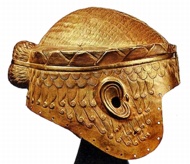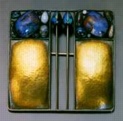

Examples of works in gold:

Russia, North Caucasus, Maikop Burial Mound,
Figure of a Bull, 3rd millennium
BCE,
gold, height 6 cm, Hermitage
Museum, St. Petersburg, Russia.

Mesopotamia, Royal Cemetery at Ur, Gold Helmet of King Meskalamdug, c. 2400 BCE, repoussé gold, height 22 cm, greatest diameter 26 cm. The decoration of the helmet simulates the king's crown, hair, and ears. Holes drilled along the lower edges enabled the attachment of an inner helmet. This is one of many Mesopotamian objects that have recently been lost or stolen from Iraq's museums, and have yet to be recovered. The Oriental Institute of the U of Chicago has posted a database of treasures that have been lost or stolen from Iraq. See arms and armor.

Probably Southern Germany, Conical Hat with Brim, Late Bronze Age
(1000 BCE),
gold sheet with embossing,
height 74.5 cm, weight
490 grams, Museum für Vor- und Frühgeschichte, Berlin.
See crown.

Russia, Krasnodar Region, Kuban area, Kelermes
burial mound N1, Shield Emblem in the Form of a Panther,
late 7th-early 6th centuries BCE,
gold, enamel, 16.2
x 32.6 cm, Hermitage Museum, St. Petersburg, Russia.

Greece, Temple Pendant with the Head of Athena Parthenos,
first half of the 4th century BCE,
gold, enamel, State
Hermitage Museum, St. Petersburg, Russia. See pendant.

Bosporan Kingdom (Black Sea Coast), in Greek
style, Necklace (Pectoral), first half of the
4th century BCE,
gold, enamel, diameter 18.4 cm, State Hermitage
Museum, St. Petersburg, Russia. See pectoral.

Hellenistic, Phiale, c. 300 BCE, repoussé gold, diameter 23 cm, Metropolitan Museum of Art, NY. In the center of this phiale is a large boss representing the omphalos, the mythic navel of the universe. A radial pattern of acorns and bees, each symbolizing the earth's "victual in plenty," as described by Hesiod. See Hellenistic art.
![]()
Greek, Alexandria, Egypt, 220 BC - 100 BCE,
Hairnet, gold, garnet, and glass
paste, 8 1/2 x 3 1/8 x 3 inches (21.5 x 8 x 7.5 cm), J. Paul
Getty Museum, Malibu, CA.

Panama, Double Eagle Pendant, 1st-5th century
CE,
Initial Style, cast gold,
height 4 3/8 inches (11.1
cm), Metropolitan Museum of Art, NY. See jewelry and Pre-Columbian
art.

Costa Rica, Puntarenas Province, Chiriquí,
Frog Pendant, 11th-16th century, cast gold, height
4 1/8 inches (10.5 cm), Metropolitan Museum of Art, NY. See jewelry and
Pre-Columbian art.
Chinese, Cloth of Gold, after 1220, cloth of gold, lampas weave, silk and gold thread, height 134.5 cm, Cleveland Museum of Art.
Maison (House of) Froment-Meurice, goldsmiths under the direction of François-Désiré Froment-Meurice (French, 1802-1855), in collaboration with the architect Duban, sculptors Feuchère and Geoffroy-Dechaume, ornamenter [decorator?] Liénard, enamelers Sollier, Grisée, and Meyer-Heine, The Duchess of Parma's Golden Casket of Toiletries, partially gilt, copper-gold, enamel on copper, blue glass, emeralds and garnets, c. 1847, 42.6 x 35.8 x 27.5 cm, Musée d'Orsay, Paris.


American, designed by Augustus Saint-Gaudens
(American,1848-1907), Double Eagle, 1907, 90% gold, 10% copper, obverse
and reverse. Augustus
Saint-Gaudens was commissioned
to re-design the coinage of the United States so that it would
compare favorably with
the "beauty
and dignity" of ancient
Greek coins. See numismatics.

Josef Hoffmann (Austrian, 1870-1956) for
Wiener Werkstätte, Square Brooch, silver lattice, repoussé gold, and opal, c. 1905. See Art Nouveau, jewelry, opalescence, and secession.
Gold is usually alloyed
to increase its strength, "24 karat" signifying pure,
lower numbers proportionately
less pure. When used for sculpture, gold is generally alloyed
with copper or silver. Gold's atomic symbol Au; atomic number
79; atomic weight 196.967; melting point 1,063.0°C; specific
gravity 19.32; valence 1, 3. Also, a light olive-brown to dark
yellow color, or a moderate, strong
to vivid yellow.
Also see electroplate, gilding, gilt or gilded, gold leaf, Golden Mean, and ormolu.
https://inform.quest/_art